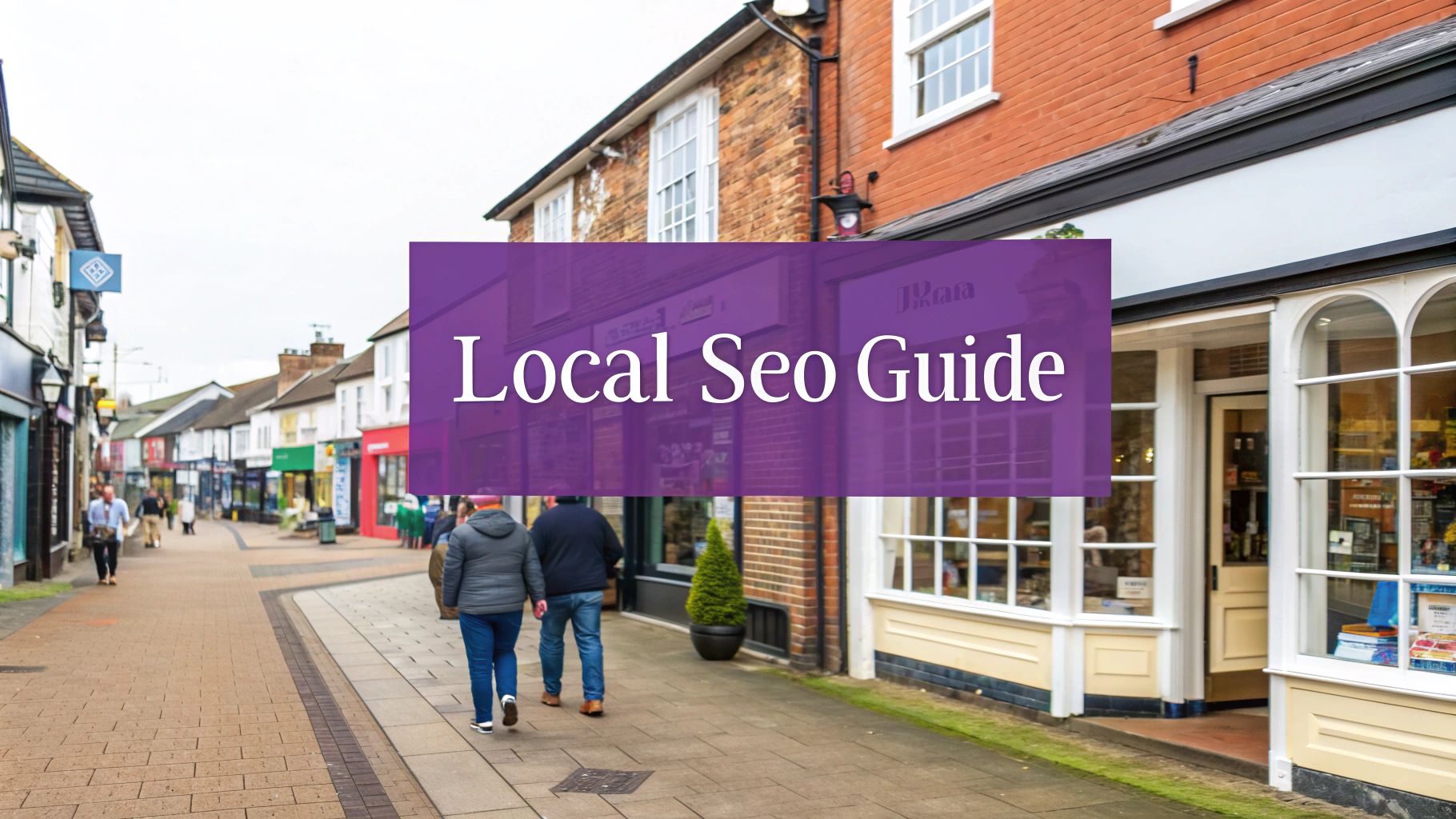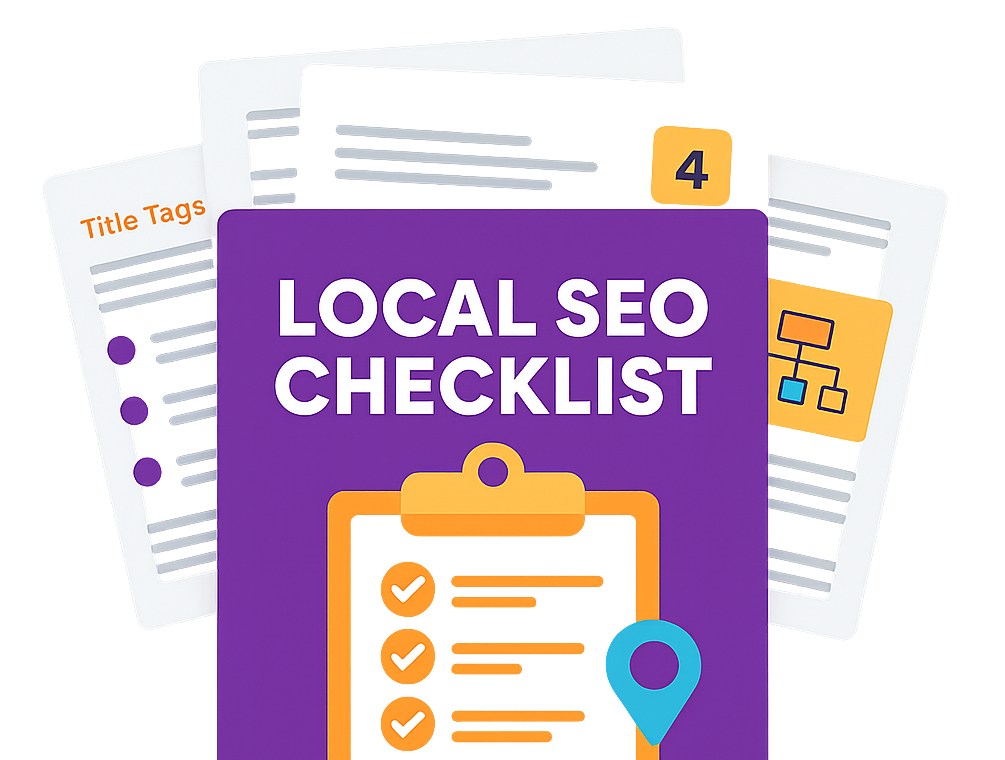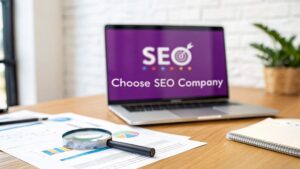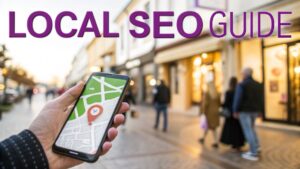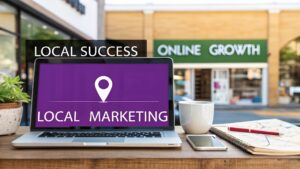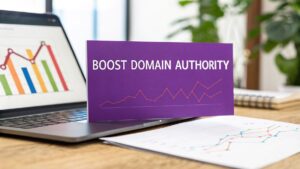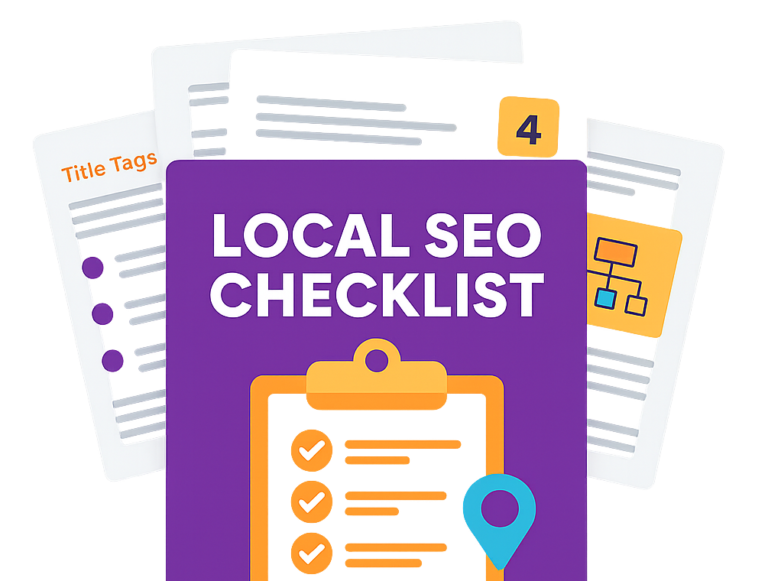Local SEO for a small business isn't about taking on the world; it’s about winning your own neighbourhood. It's the art of optimising your online presence so that when someone down the street needs what you offer, you’re the first business they find. Think of it this way: a strong presence in local search results and on Google Maps is what drives real-world foot traffic, phone calls, and website enquiries.
Why Local SEO Is Your Biggest Opportunity
As a small UK business, your biggest strength is your connection to the local community. You're not trying to outmuscle national chains or global corporations. You're trying to be the go-to choice for people in your town. This is exactly where local SEO levels the playing field, giving you a powerful, almost unfair, advantage.
Let's face it, nobody uses the Yellow Pages anymore. Instead, they pull out their phones and search for 'best coffee near me', 'emergency plumber in Bristol', or 'Cambridgeshire bookshop open now'. That’s the moment of truth. That’s when your business absolutely has to show up.
Connecting with High-Intent Customers
When someone makes a local search, they're not just browsing. They have a specific, immediate need and are usually ready to buy. The data backs this up completely: around 30% of all mobile searches are location-related, and an incredible 80% of those local searches lead to a purchase, often on the very same day. These aren't just numbers; they represent a massive pool of ready-to-act customers right on your doorstep.
This is all about translating your neighbourhood presence into actual customers walking through your door.
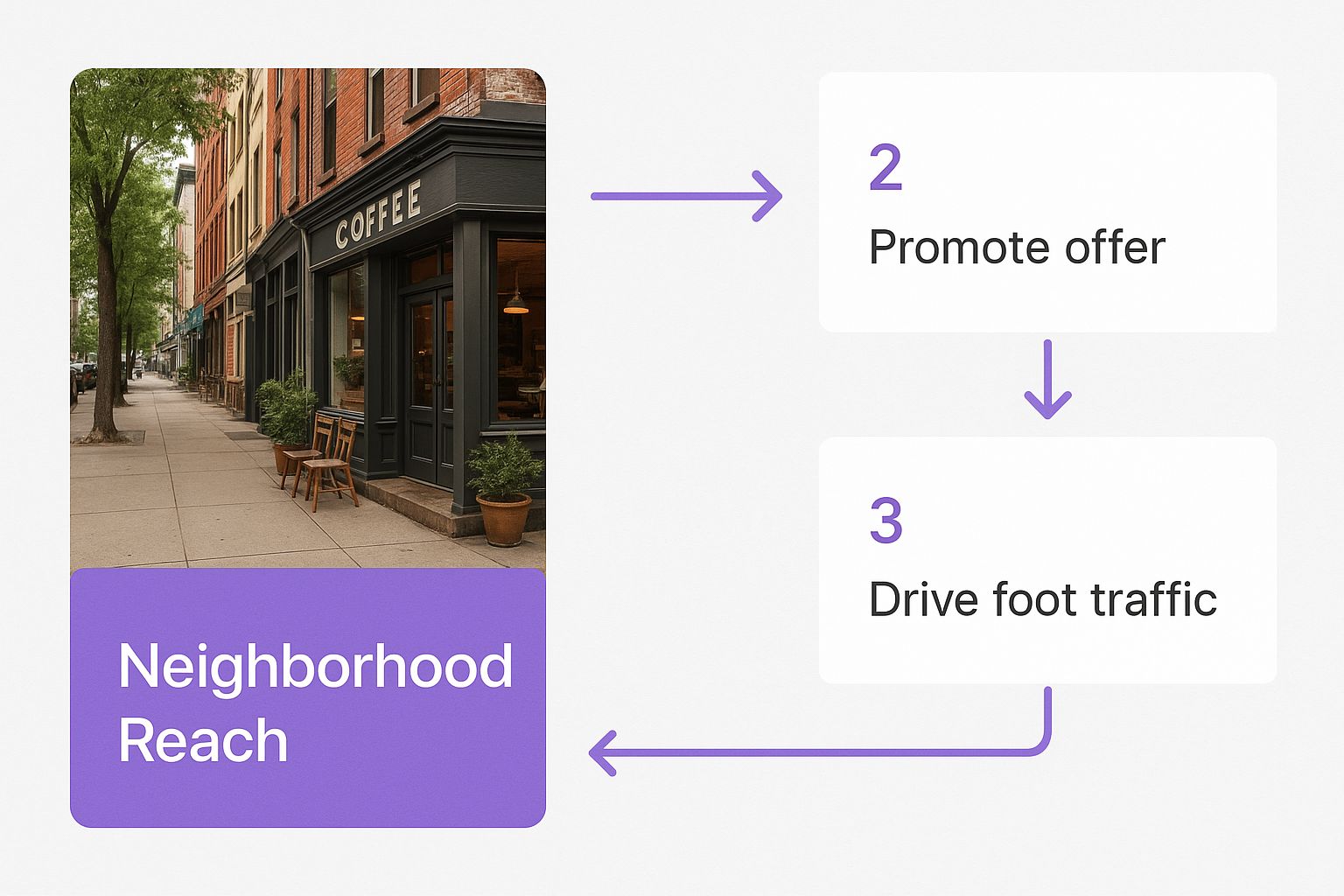
The image drives home a simple point: local SEO isn't just about rankings. It’s about becoming a visible, trusted part of your local high street online.
Building Trust and Authority Locally
Showing up consistently in local searches does more than just bring in leads—it builds genuine trust. When potential customers see your business pop up on Google Maps or in the "local pack" results time and time again, it sends a powerful subconscious signal: you're a legitimate, established, and reliable local option.
By focusing your efforts on your immediate geographic area, you can build a powerful digital footprint that larger, less-localised competitors simply can't replicate. This is your key to sustainable growth.
The sheer number of benefits of local SEO makes it an absolute must-have in any small business's marketing toolkit. For owners looking to get a solid strategy in place, this detailed guide to local SEO services for small businesses offers some fantastic, practical insights. By mastering local search, you make sure your business is the first one customers find, right when they need you the most.
Optimising Your Google Business Profile
Think of your Google Business Profile (GBP) as the digital front door to your business. It’s often the very first thing a potential customer sees, popping up in Google Search and on Maps. Just treating it as another online listing is a massive missed opportunity. In reality, it's your single most powerful tool for pulling in local customers.
A well-oiled profile does more than just list your opening hours. It builds trust, shows off your brand’s personality, and gives people solid reasons to pick you over the competition down the road. Moving beyond the basic setup is a non-negotiable for any small business that's serious about winning at local SEO.
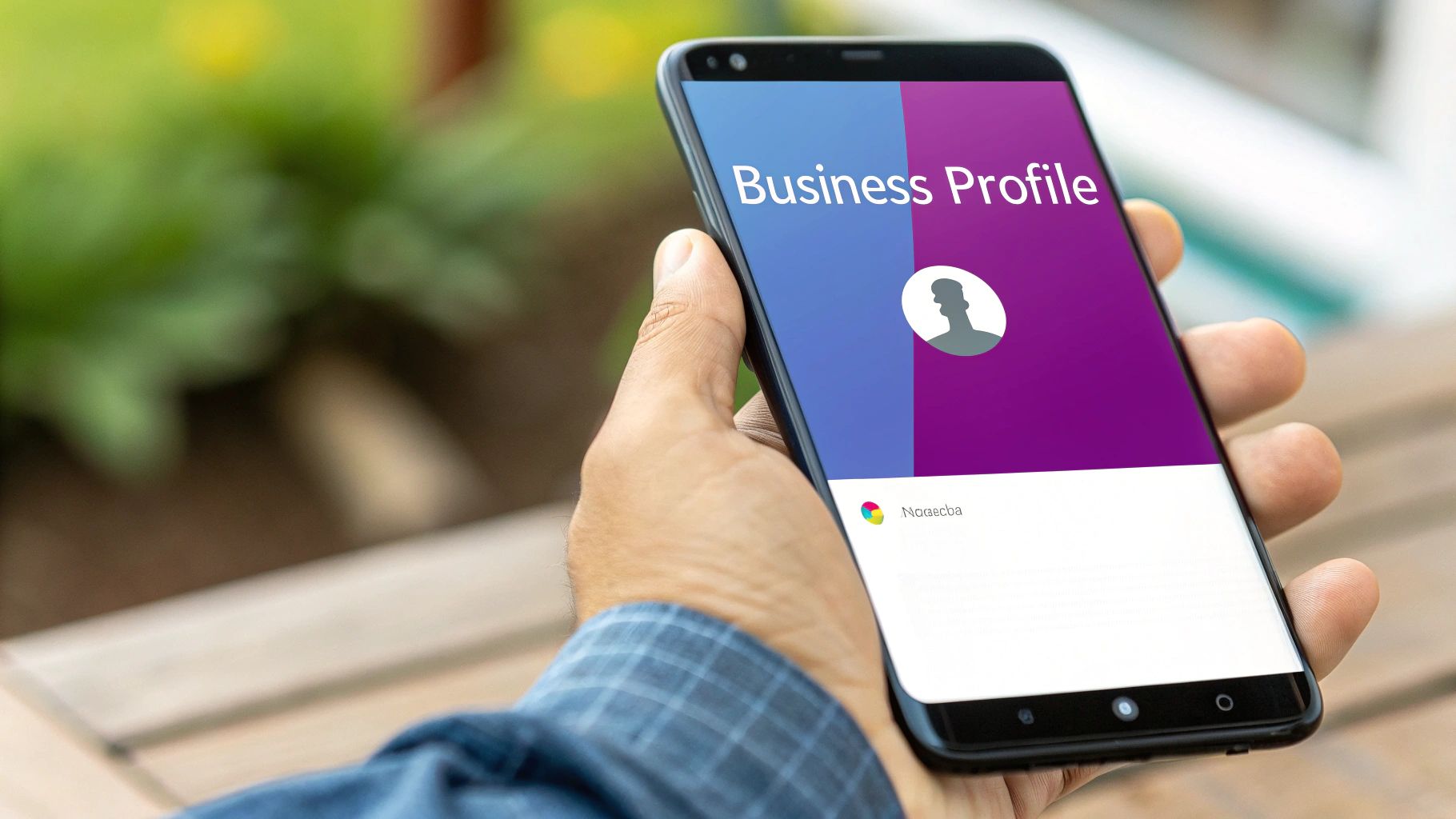
This isn’t about just filling in boxes; it's about strategically presenting your business in a way that turns casual searchers into loyal, paying customers.
Choosing Your Core and Secondary Categories
One of the first, and most critical, steps is picking the right business categories. This decision flat-out tells Google what you do and which searches you should show up for. It’s surprisingly easy to get this wrong by being too vague.
Let’s say you run a café that’s famous for its artisan coffee and homemade cakes. Choosing "Cafe" as your primary category is a decent start, but don't stop there. You should also add secondary categories like "Coffee Shop," "Cake Shop," and "Patisserie." This helps you show up for a much wider range of local searches.
- Primary Category: This is your bread and butter. Be as specific as you can. Don't just pick "Restaurant"; choose "Italian Restaurant" or "Vegan Restaurant."
- Secondary Categories: These cover everything else you offer. A "Plumber," for instance, might also add "Boiler Repair Service" and "Central Heating Engineer."
Nailing this from the start ensures you’re attracting the right crowd.
Crafting a Compelling Business Description
You get 750 characters for your business description—make them count. This is your elevator pitch, a prime piece of real estate to tell your story and naturally weave in important local keywords. Avoid just listing services. Tell people what makes you special.
A bland description might read: "We are a bakery in Cambridge. We sell bread and cakes." Yawn.
Now, let’s give it some life: "Discover Cambridge's favourite artisan bakery, nestled in the heart of Mill Road. For over a decade, our family-run shop has been handcrafting sourdough bread, speciality cakes, and freshly brewed coffee for the local community. Visit us for the best baked goods in Cambridgeshire."
See the difference? This version includes location-specific keywords ("Cambridge," "Mill Road," "Cambridgeshire") and highlights unique selling points ("artisan," "family-run," "handcrafting"). It’s far more appealing to both Google and actual humans.
A great business description does more than inform—it persuades. It connects with local customers on a personal level and gives them a reason to visit, making it a cornerstone of effective Google Business Profile optimisation.
The Power of Visuals and Regular Updates
Photos and posts are what bring your profile to life. They give people a real glimpse into your business, building transparency and trust before they even walk through the door. The numbers don't lie: profiles with more photos get 42% more requests for driving directions and 35% more clicks to their websites.
Make it a habit to upload high-quality, geotagged images. Show off your:
- Exterior: Help people spot you from the street.
- Interior: Let them see the vibe inside.
- Products/Services: Show, don't just tell, what you offer.
- Team: Put a friendly face to your business name.
Google Posts are another brilliant feature, acting like mini-adverts right on your profile. Use them to shout about special offers, upcoming events, new products, or company news. Posts expire after seven days, so keeping them updated signals to Google that you're active and engaged—something the algorithm loves.
Finally, don't neglect the Q&A section. Get ahead of the game by adding and answering common questions yourself. Think about things like parking, accessibility, or booking policies. It’s a simple way to help customers and position yourself as a helpful local expert.
Google Business Profile Optimisation Checklist
To help you stay on track, here's a checklist covering the essential and more advanced tasks for a fully optimised profile. Working through this list will put you miles ahead of the competition.
| Task | Impact Level | Why It's Important |
|---|---|---|
| Claim & Verify Profile | High | This is the first step. It proves ownership and unlocks all optimisation features. |
| Complete All Sections | High | A 100% complete profile is trusted more by Google and users. Don't skip anything. |
| Select Specific Categories | High | Directly tells Google which local searches you are relevant for. |
| Upload High-Quality Photos | High | Increases engagement, builds trust, and makes your business look professional. |
| Add Local Phone Number | High | Essential for local customers to contact you and for NAP consistency. |
| Write a Keyword-Rich Description | Medium | Your chance to sell your business and include relevant local search terms naturally. |
| Publish Regular Google Posts | Medium | Keeps your profile fresh, promotes offers, and signals activity to Google. |
| Gather & Respond to Reviews | High | A major ranking factor. Shows you value customer feedback and builds social proof. |
| Enable Messaging Feature | Medium | Offers a direct and easy way for potential customers to get in touch. |
| Set Up and Manage Q&A | Medium | Proactively answers customer questions and showcases your expertise. |
| Add Products/Services | Medium | Clearly lists what you offer, often with pricing, making it easier for customers to buy. |
| Add Business Attributes | Low | Highlights specific features like "wheelchair accessible" or "free Wi-Fi." |
Ticking off these items systematically will ensure your GBP isn't just a placeholder but a powerful engine for driving local business. For a deeper dive, our comprehensive guide on Google Business Profile optimisation covers these elements in much more detail.
Sending the Right On-Page Local Signals
Once your Google Business Profile is dialled in, it's time to get your website singing from the same hymn sheet. Think of your website as a massive beacon, constantly firing signals to search engines about who you are, what you do, and—most crucially—where you do it. This whole process is called on-page SEO, and it’s all about weaving your local identity into the very fabric of your site.
So many small businesses fall at this hurdle. They keep their website content way too generic. They might say they're an ‘artisan baker’ but completely forget to mention they're an ‘artisan baker in Bristol’. That tiny omission is a huge missed opportunity. To really win at local SEO for small business, your website needs to shout your location from every digital rooftop.
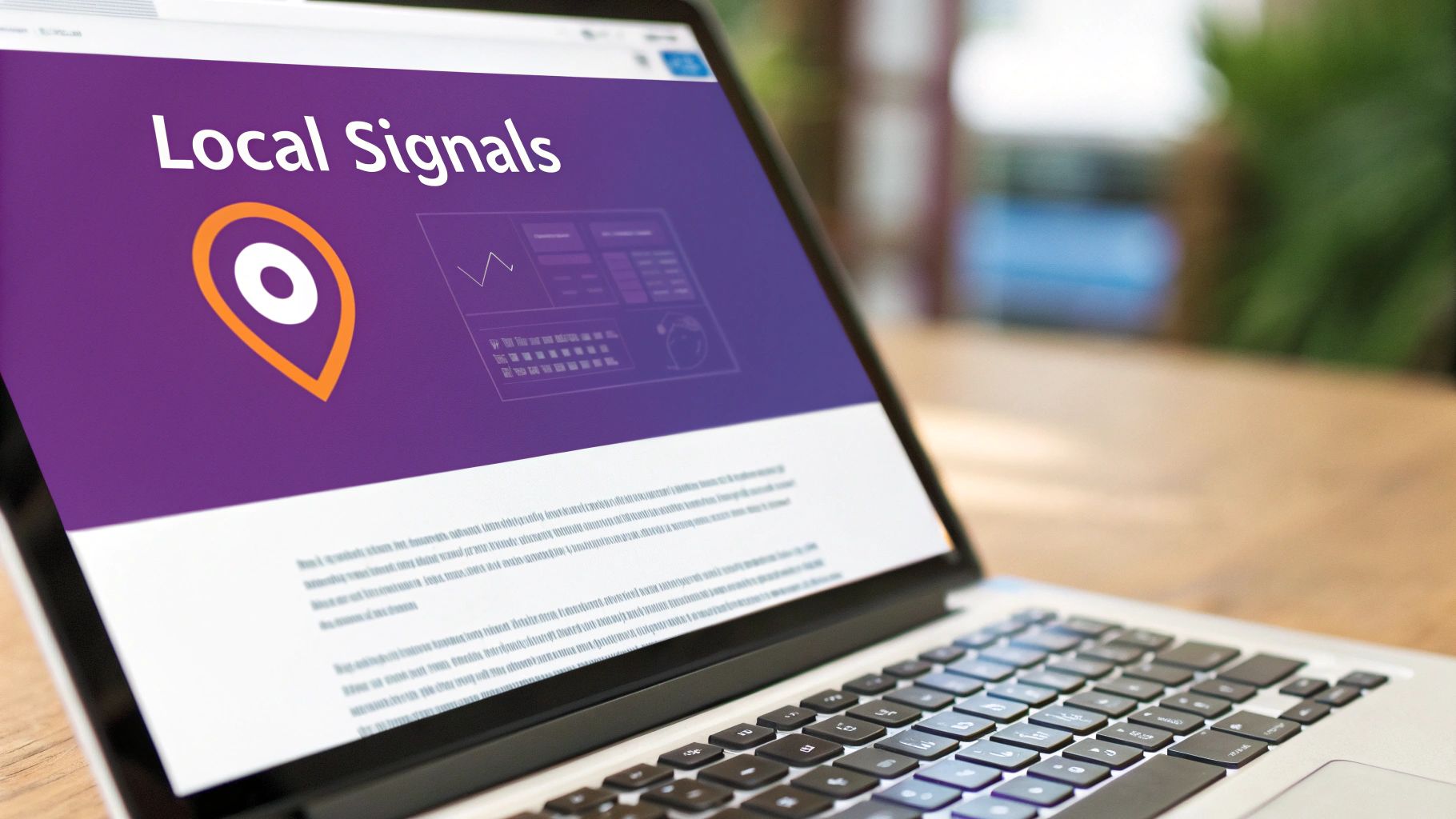
But this isn't about clumsily stuffing your town's name everywhere. It’s about creating an experience that's genuinely helpful and relevant for both Google and the real people visiting your site.
Optimising Titles and Meta Descriptions
Let's start with the low-hanging fruit: your page titles and meta descriptions. These are the first things people see in the search results, so they've got to do two jobs at once—be compelling enough to earn a click and contain the right local keywords.
Here’s a simple before-and-after for a plumber in Manchester.
- Before Title: Plumber | Emergency Callouts
- After Title: Expert Emergency Plumber in Manchester | 24/7 Callouts
The "after" version is miles better. It instantly tells Google and the searcher exactly what the service is and where it's offered. It’s far more likely to show up for a search like ‘emergency plumber Manchester’. Small change, massive impact. Of course, to get this right, you need to know what your local customers are actually typing into Google, which is why it's so important to conduct expert keyword research first.
The Non-Negotiable NAP Consistency
Your Name, Address, and Phone number (NAP) is your digital fingerprint. It is absolutely non-negotiable that this information is identical across your website, your Google Business Profile, and every single online directory you’re listed on.
Even a tiny difference, like using ‘St.’ on your website but ‘Street’ on GBP, can throw a spanner in the works. These little inconsistencies confuse search engines and slowly chip away at your local authority. I always recommend having a dedicated contact page and, crucially, putting your full NAP details in the footer of every single page. It's the best way to ensure maximum visibility and consistency.
Your NAP is the bedrock of local trust online. Keep it clean, keep it consistent, and check it obsessively. Any inconsistency, no matter how minor, introduces doubt for search engines.
This obsessive attention to detail is a cornerstone of a solid local SEO foundation. If you want to dive deeper into the technical side, our guide on on-page SEO best practices is a great place to start.
Creating Localised Content and Service Pages
If your business serves multiple areas, creating dedicated pages for each location is an absolute game-changer. Imagine a landscaper who works across Cambridgeshire. They could have separate pages for ‘Garden Design in Cambridge’, ‘Patio Installation in Ely’, and ‘Lawn Care in St Ives’. Each page needs to have unique content that speaks directly to that specific area.
This strategy lets you rank for all those hyper-local search terms that your competitors are probably ignoring. But don't just stop at service pages. Think about blog content that resonates with your local community.
- A Scottish Highlands tour guide could write: ‘A Guide to Hiking Ben Nevis in Autumn’.
- A bakery in Cornwall could post: ‘The History of the Cornish Pasty’.
- A solicitor in London might publish: ‘Navigating Property Law in Kensington and Chelsea’.
Content like this does more than just attract a super-relevant local audience; it positions you as the go-to expert in your community. Given that 53.3% of all website traffic comes from organic searches, and Google dominates over 90% of web traffic, it’s a powerful, cost-effective way to get qualified leads through the door.
One last thing—don't forget to embed a Google Map on your contact page. It's such a simple move, but it's a powerful signal that confirms your physical location to Google and makes it dead simple for customers to find you.
Building Local Trust with Citations and Reviews
Beyond what you say on your own website, your local reputation really gets built on two things: citations and reviews.
Think of them as the digital version of word-of-mouth. They’re powerful signals for potential customers and search engines, proving your business is a legitimate, trusted part of the local community. Nailing these is a core part of any good local SEO for small business strategy. They tell Google you are who you say you are, and where you say you are—which is exactly what you need to show up in local search.
Mastering Citations for Local Authority
Simply put, a citation is any online mention of your business's Name, Address, and Phone number (what we call NAP). You’ll find them on local business directories, websites for your specific industry, or even local blogs. Each consistent citation is like a small vote of confidence, reinforcing your location and contact details for Google.
The key word there is consistency. Just like the NAP on your website, every single citation out there on the web needs to be identical. Even a tiny difference, like using "Ltd" in one listing and "Limited" in another, can cause confusion and weaken the authority these citations provide.
Your job is to build a strong, consistent profile across all the right platforms. For UK businesses, this starts with the big data aggregators and well-known directories.
- Foundational Directories: Start with the essentials. Get listed on major UK platforms like Yell, Thomson Local, and Scoot. These are often the first places search engines check.
- Industry-Specific Sites: Next, find directories that are relevant to your trade. A builder, for example, would want to be on Checkatrade, while a restaurant should be all over TripAdvisor.
- Hyperlocal Platforms: Don’t overlook websites focused specifically on your town or county. A mention on a local community blog or a business association list can be surprisingly powerful.
Building out this network of consistent citations is a grind, but it’s a non-negotiable step for a solid local SEO foundation. If you're looking to speed things up, our guide on local directory submissions offers a more structured way to tackle it.
The Immense Power of Customer Reviews
While citations build foundational trust with search engines, reviews are all about building trust with actual people.
Positive reviews are probably the single most powerful conversion factor in local search. When a potential customer sees a string of glowing four and five-star reviews, it massively reduces the perceived risk of choosing your business.
The real challenge isn't just getting reviews, but encouraging a steady stream of them from your happy customers. The secret is to make it incredibly easy for them to share their feedback.
Remember, you're not just collecting stars; you're collecting stories. Each review is a piece of user-generated content that highlights what makes your business special, providing fresh, relevant text that Google loves.
Here’s how you can ethically encourage more reviews:
- Ask at the right time: The perfect moment to ask for a review is right after a positive experience—maybe when you’ve just finished a successful project or a customer has given you direct praise.
- Make it simple: Give them a direct link to your Google review page. You can send it via email, text message, or even put a QR code on your business cards. The fewer clicks it takes, the more likely they are to do it.
- Personalise the request: A simple, personal email goes a long way. Something like, "Hi [Customer Name], we loved working with you on [Project]. If you have a moment, we'd be grateful if you could share your experience on Google," is so much more effective than a generic, automated blast.
Turning All Feedback into an Opportunity
Responding to reviews—both the good and the bad—is just as important as getting them in the first place. When you reply, it shows you’re engaged, you care about what people think, and you’re committed to great customer service.
For positive reviews, a genuine thank you is often enough. It also helps to mention the specific service they enjoyed to subtly add more keywords to your profile. For instance, "Thanks, Sarah! We're so glad you enjoyed our bespoke cake design for your anniversary."
Negative reviews can feel like a punch to the gut, but they are a golden opportunity. A calm, professional, and helpful response can often turn a bad situation around. Always acknowledge their issue, apologise that their experience wasn’t up to scratch, and offer to take the conversation offline to fix it. This public display of excellent customer service shows potential new customers that you take accountability seriously.
Tracking the Metrics That Actually Matter
All that hard work getting your local SEO in shape means very little if you can't actually tell whether it's moving the needle. Tracking your performance isn’t about getting lost in endless spreadsheets; it’s about zeroing in on the numbers that show a real return on your time and effort.
A common mistake is trying to track everything at once. Instead, we need to cut through the noise and focus on the handful of metrics that genuinely impact your bottom line. Success in local SEO for a small business is measured in real-world results—think phone calls and feet through the door, not just vanity metrics like impressions.
Your Local SEO Dashboard
The great news is you don’t need to splash out on expensive software to get started. Google gives you a couple of powerful, free tools that provide all the essential data you need. The two you'll live in are your Google Business Profile Insights and Google Search Console.
Think of these as your command centre. They give you a clear, unfiltered look at how real people are finding and interacting with your business online. Getting comfortable here is your first step towards making smarter, data-driven decisions.
Your Google Business Profile (GBP) Insights dashboard is especially important. This is where you see the direct actions customers take right after finding you.
These actions are the lifeblood for any local business:
- Clicks-to-call: This is a straightforward count of how many people tapped the "Call" button on your profile. It's a direct measure of new enquiries.
- Direction requests: This shows how many people asked Google Maps for directions to your physical address. It’s the clearest sign that your online presence is driving actual foot traffic.
- Website clicks: This tracks the number of people who visited your website after seeing your profile, showing how your GBP is feeding your main online hub.
Tracking these specific interactions is absolutely vital. They connect the dots between your online efforts and tangible business outcomes, like a ringing phone or a new customer walking in.
Analysing Search Performance
While GBP Insights shows you what people do, Google Search Console tells you how they found you in the first place. It reveals the exact search terms that led users to your website and where you’re ranking for them.
You’ll want to pay close attention to keywords that include your location, like "emergency plumber in Bristol" or "best coffee near Cambridge station." Watching your rankings for these local searches is crucial. If you see them climbing over time, you know your on-page SEO and citation building are paying off.
Understanding this search behaviour is everything. In the UK, around 46% of all Google searches now have local intent, meaning nearly half of all users are looking for something nearby. When you also know that 76% of these local searchers visit a business within 24 hours, the importance of tracking and improving your local rankings becomes crystal clear. You can dig deeper into how local search drives real business by checking out these insights on the benefits of local SEO.
By checking this data regularly, you’ll spot new opportunities, see what's working, and constantly refine your strategy to bring more high-intent customers right to your doorstep.
Got a Few Questions About Local SEO?
Diving into local SEO for your small business can feel like you're learning a new language. You've probably got a few nagging questions about how it all works in the real world. I get it. Let's tackle some of the most common ones I hear from business owners just like you.
We'll clear up the confusion around everything from how long it takes to see results to whether you actually need a high-street shopfront to get noticed.
How Long Does Local SEO Take to Work?
This is the big one, and the honest answer is: it depends. Local SEO isn't an overnight fix; it’s more like planting a garden than flipping a switch. You're building genuine authority and trust with search engines, and that simply takes time.
Generally, you can expect to see some real movement within three to six months. This could be a jump in your local keyword rankings or a noticeable uptick in calls coming directly from your Google Business Profile.
But that timeline is influenced by a few key factors:
- How stiff is the competition? If you’re a plumber in a crowded market like central London with dozens of competitors all doing their SEO homework, it’s going to take longer to climb the ladder.
- What's your starting point? A business with an unverified, empty GBP and a ten-year-old website has a much longer road ahead than one that’s already got the basics dialled in.
- Are you consistent? Regularly publishing Google Posts, actively gathering new reviews, and building citations will speed things up massively compared to a 'set it and forget it' approach.
The key is to see local SEO as an ongoing investment. The initial push takes the most effort, but the long-term rewards of consistent management are huge.
Do I Need a Physical Address to Rank Locally?
This is a massive point of confusion, especially for service-area businesses (SABs) like electricians, consultants, or mobile dog groomers who travel to their clients.
The short answer is yes, you do need a physical address to verify your Google Business Profile. But—and this is the important part—you absolutely do not have to make that address public.
During the GBP setup, Google gives you the option to specify that you're a service-area business. When you tick that box, you can define the postcodes or towns you serve, and Google will hide your street address from your public profile. This is a game-changer for home-based business owners who need local visibility without putting their home address on the map.
You cannot use a P.O. box or a virtual office address for verification. Google's rules on this are incredibly strict; the address must be a real location where you can receive mail. It's all about proving you're a legitimate local business.
This setup means you can still show up in local searches and on Google Maps for your designated service area, levelling the playing field between businesses with a shopfront and those without.
How Do I Handle Multiple Business Locations?
Managing local SEO when you have more than one branch needs a structured, consistent approach. Whatever you do, don't try to cram all your locations onto a single webpage—it’s a recipe for confusing both Google and your customers.
The best practice is crystal clear:
- Create a separate Google Business Profile for each location. Every single branch needs its own unique profile with its specific address, phone number, and opening hours. No exceptions.
- Build dedicated location pages on your website. Each physical branch should have its own page (e.g.,
yourwebsite.co.uk/cambridgeandyourwebsite.co.uk/ely). These pages must have unique content about that specific location, including the local NAP, testimonials from local customers, and an embedded Google Map. - Build citations for each location individually. When you're getting listed on directories like Yell or Checkatrade, create separate listings for each branch. Make sure each one points back to its own unique location page on your site.
Consistency is everything. Each location's online footprint should be treated as its own distinct entity, with all signals pointing clearly to that specific address. This stops you from confusing search engines and helps each branch rank effectively in its own local patch.
What Is the Main Difference Between Local and Traditional SEO?
While they're built on many of the same principles, the core difference between local SEO and traditional (or national) SEO boils down to one thing: geographical intent.
Traditional SEO aims to make a website visible to a broad audience, whether that’s national or even global. It focuses on general keywords like "buy running shoes" or "content marketing software." The user's location isn't really part of the equation.
Local SEO, on the other hand, is hyper-focused on a specific geographic area. It targets searches with clear local intent, like "running shoe shop near me" or "Cambridge content marketing agency." The entire strategy is built around proving your relevance to a customer in a particular town, city, or region. This means optimising things like your Google Business Profile and local citations—elements that are far less important in a traditional SEO campaign.
Think of it this way: traditional SEO is casting a wide net across the ocean. Local SEO is precision fishing in your own pond. For small businesses serving a specific community, mastering that precision is what really moves the needle.
Ready to turn these insights into action? A strong local SEO strategy is hands-down the most effective way to connect with customers right on your doorstep. At Bare Digital, we specialise in creating bespoke SEO plans that deliver real, measurable results for businesses across Cambridgeshire and beyond.
Start with our free SEO Health Check to see exactly where you stand. We'll give you a clear, actionable plan to boost your local rankings and drive more customers your way. Get your custom proposal today at https://www.bare-digital.com.

